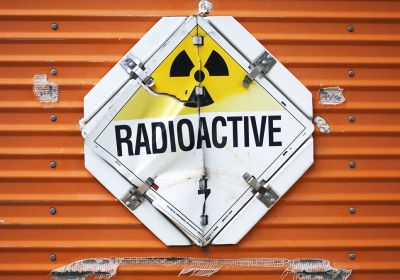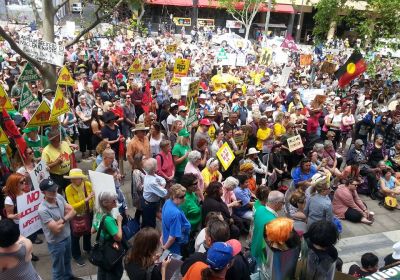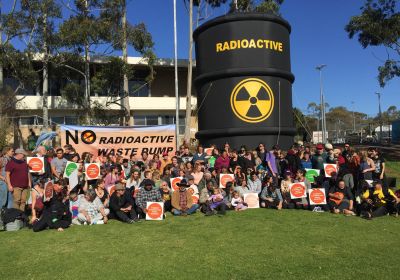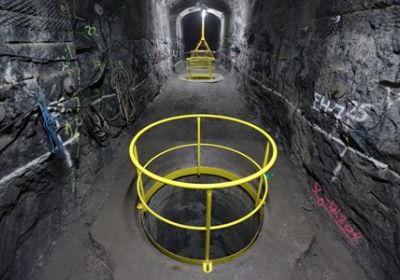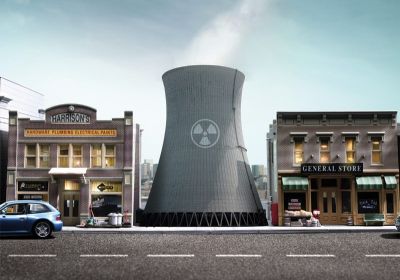-
-
-
-
-
-
 Despite the rain, about 100 people rallied in Hyde Park on August 6 to declare, "Hiroshima Never Again," on the 71st anniversary of the US atomic bombing of the Japanese city of Hiroshima in 1945. The themes of the rally were: "Ban nuclear weapons," and "No nuclear waste dumps in Australia". A dramatic round of traditional drumming by a local Japanese cultural group and a set by the band Urban Guerrillas kicked off the rally.
Despite the rain, about 100 people rallied in Hyde Park on August 6 to declare, "Hiroshima Never Again," on the 71st anniversary of the US atomic bombing of the Japanese city of Hiroshima in 1945. The themes of the rally were: "Ban nuclear weapons," and "No nuclear waste dumps in Australia". A dramatic round of traditional drumming by a local Japanese cultural group and a set by the band Urban Guerrillas kicked off the rally. -
 About 150 opponents of the proposed site of a radioactive waste dump in South Australia's Flinders Ranges gathered on June 24 in Port Augusta to voice their opposition. The federal government has recently shortlisted Barndioota station near Hawker as the site of a national nuclear storage facility. The area, where a number of songlines cross and which hosts a sacred women's site, is of immense cultural significance for the Adnyamathanha people and has been proven to be immensely rich in Aboriginal heritage.
About 150 opponents of the proposed site of a radioactive waste dump in South Australia's Flinders Ranges gathered on June 24 in Port Augusta to voice their opposition. The federal government has recently shortlisted Barndioota station near Hawker as the site of a national nuclear storage facility. The area, where a number of songlines cross and which hosts a sacred women's site, is of immense cultural significance for the Adnyamathanha people and has been proven to be immensely rich in Aboriginal heritage. -
 In the plans of governments in Adelaide and Canberra, South Australia is to become the country’s “nuclear waste dump state”. Most South Australians remain sceptical. And among the state’s Aboriginal population — on whose ancestral lands the dumps would be located — opposition to the scheme is rock-solid. “It’s very simple and easy to understand,” Aboriginal activist Regina McKenzie told Green Left Weekly on May 24. “No means no!” In the plans of governments in Adelaide and Canberra, South Australia is to become the country's “nuclear waste dump state”.
In the plans of governments in Adelaide and Canberra, South Australia is to become the country’s “nuclear waste dump state”. Most South Australians remain sceptical. And among the state’s Aboriginal population — on whose ancestral lands the dumps would be located — opposition to the scheme is rock-solid. “It’s very simple and easy to understand,” Aboriginal activist Regina McKenzie told Green Left Weekly on May 24. “No means no!” In the plans of governments in Adelaide and Canberra, South Australia is to become the country's “nuclear waste dump state”. -
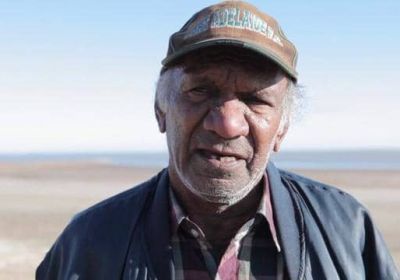 The front page headline “Trash and treasure” on the February 16 edition of South Australia's only daily newspaper, The Advertiser, welcomed the recommendation from the Nuclear Fuel Cycle Royal Commission for a nuclear waste dump in outback SA. The commission had cost a massive tax-payer funded $8 million.
The front page headline “Trash and treasure” on the February 16 edition of South Australia's only daily newspaper, The Advertiser, welcomed the recommendation from the Nuclear Fuel Cycle Royal Commission for a nuclear waste dump in outback SA. The commission had cost a massive tax-payer funded $8 million. -
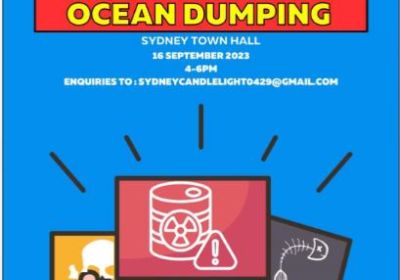
- Gadigal Country/Sydney
Nuclear dumps, storage and waste
Nuclear dumps, storage and waste
